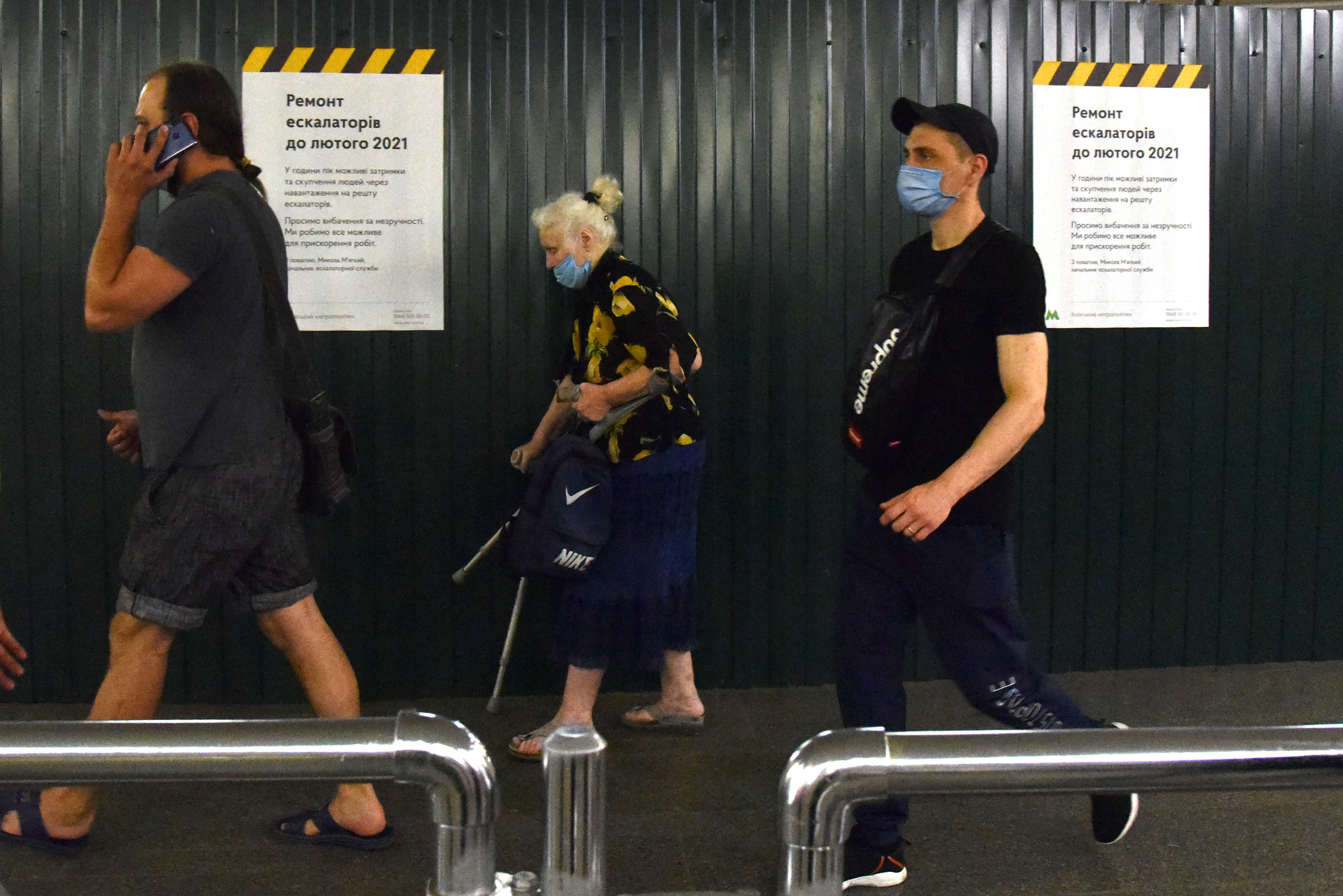Impact of the COVID-19 Pandemic on Ukraine’s Economy

Economy amidst the Crisis
Restrictions on business activity introduced by the Ukrainian government in mid-March to counteract the spread of COVID-19 coincided with an economic slowdown in Ukraine (in the first quarter of 2020, for the first time since 2015, GDP fell). As a result, the Ukrainian economy was already in deep recession in April. In the period January to April 2020, GDP shrank by 5%, year on year[*] (y/y), although due to the large shadow economy (estimated at 30–47% of GDP) the actual decline in economic activity was probably greater. Particularly affected have been sectors dependent on domestic demand (transport, trade, construction), which have suffered from the government restrictions (e.g., suspension of passenger transport, closure of restaurants and shopping centres), as well as industry that has felt the fall in global metallurgical raw material prices. The situation has been further aggravated by the fall in remittances from abroad—by about 13% y/y in April—mainly because of COVID-19 restrictions in EU countries. Remittances have been an important driver of domestic consumption in recent years, amounting to about 8% of GDP in 2019.
The downturn has led to a rapid increase in unemployment. The Ukrainian Chamber of Commerce and Industry (UCCI) estimates that the rate nearly doubled during the first month of the restriction period and could have exceeded 15% in April, including probably several hundred thousand economic migrants who returned to the country after the outbreak of the pandemic. In contrast, preliminary data indicate that COVID-19 had a moderate impact on the volume of Ukrainian exports, which fell by less than 4% y/y between March and April. This was facilitated by an increase in sales to Asian markets, mainly China, which compensated for the lower demand on the EU market resulting from restrictions in the Member States.
Anti-Crisis Measures
After the outbreak of the pandemic, the Ukrainian parliament, as in other countries, adopted a package of laws to counteract the economic impact of COVID-19, including offering temporary tax exemptions, postponing the deadline for payment of income taxes, and raising the tax thresholds for sole proprietorships. Enterprises also could benefit from administrative measures and small and medium-sized companies could obtain preferential loans and subsidies for employee salaries. In mid-April, a special government fund worth UAH 65 billion (about €2.2 billion) was established to combat the coronavirus, earmarked, among others, for social benefits, as well as loans to entrepreneurs. However, by the end of May—so in the period critical for the economy—only less than 1% of the funds had been spent. It is difficult to assess whether this was a deliberate action or the result of bureaucratic inefficiencies. In June, the parliament allowed the government to use these funds for the construction of road infrastructure. They are therefore likely to be allocated to public works, especially since in April Prime Minister Denys Shmyhal, citing the rise in unemployment, announced the creation of 500,000 jobs, including in the construction of transport infrastructure.
The available information indicates that the measures adopted by the Ukrainian authorities have not been properly adapted to the needs. UCCI estimated the government’s business support from tax exemptions in March and April at UAH 9.3 billion (about €300 million), yet small companies, which have been most affected by the restrictions, in total account for less than 10% of that amount. Most of them were also unable to meet the criteria for obtaining preferential loans (e.g., backed by income or real estate). The OpenDataBot, a web platform specialising in data analysis, estimated that from mid-March to mid-April, more than 270,000 people running a sole proprietorship (about 15% of the sector) had closed their business. For this reason, at the turn of April to May, there were a number of protests by representatives of small businesses, who demanded the lifting of the pandemic restrictions.
Opening the Economy
Under a still high but stable growth in the infection rate (about 400–500 new cases per day at the turn of April to May) and due to public pressure, the Ukrainian government in mid-May began to gradually lift the restrictions. Among the changes, café and restaurant gardens and non-food stores were allowed to re-open. Because of the large regional variation in the scale of the infection (most cases were in Kyiv Oblast and western Ukraine), a regional variable quarantine regime was introduced on 22 May that provides for the lifting or tightening of restrictions within a given oblast based on criteria composed of the number of tests, the rate and dynamics of growth of new infections, and the occupancy of hospital beds. Oblasts are regularly monitored and for those that meet the criteria, the local authorities may allow the resumption of most economic activity (e.g., restaurants and hotels, passenger transport), although under a stricter sanitary regime than before the pandemic.
As of 29 June, the government’s criteria were not met in 12 of the 24 oblasts as well as in the city of Kyiv, with these areas comprising more than 60% of Ukrainian GDP. It is difficult to assess when they will be ready for further easing of the restrictions because loosening them has already led to a rapid increase in infections in the country. From 22 May to 29 June, the total number of infected people since the start of the pandemic has more than doubled, from 20,000 to 44,000. In view of the worsening situation, the authorities of the Zakarpattia and Volyn oblasts (both not meeting the criteria) have again tightened the restrictions, among others, by suspending inter-regional passenger transport. If the number of infections rise, similar decisions may be taken by the authorities of other oblasts, including those currently meeting the criteria for lifting the restrictions.
Perspectives
The scale of the recession that awaits the Ukrainian economy this year is currently difficult to estimate because it depends mainly on the course of the pandemic in the country, e.g., the length of the restriction period, the number of regions covered, a possible second wave. The situation on international markets will also have a significant impact, especially when it comes to the prices of agricultural products and industrial goods, usually prone to fluctuation and which dominate Ukrainian exports. According to moderate forecasts, Ukrainian GDP will fall by about 5–8% this year. In the pessimistic scenario, assuming several more months of restrictions or a second wave of the pandemic (not necessarily in Ukraine, but, e.g., in Asia), the decrease may reach over 10%.
Short-term macroeconomic stabilisation, including coverage of the increased budget deficit resulting from the applied restrictions (estimated at 7.5% in 2020 by the government) and the ongoing repayment of foreign debt, will require external financial assistance. Ukraine can count on more than €6 billion in total support from the IMF and the EU over the next 18 months, which coupled with the current level of foreign exchange reserves (over $25 billion) and probably also new bond issuance should be adequate for the period 2020-2021. Foreign support will, however, depend on the fulfilment of certain criteria, the most important of which is maintaining the independence of the Ukrainian central bank. The longer the restrictions last, the more likely it will be that political pressure will be exerted on the bank to reduce interest rates (which already are at a record low).
The budgetary constraints mean that the Ukrainian authorities cannot afford a fiscal stimulus package proportionate to the size of the domestic economy. To enter the path of rapid growth, Ukraine therefore needs structural reforms (especially improved business conditions) to attract foreign investors. However, implementation of these reforms is unlikely to happen, since, on the one hand, it would go against the financial interests of Ukraine’s largest politico-business groups and the current authorities lack the political will to do that. On the other hand, it would lead to a temporary increase in unemployment and, consequently, to a fall in support for the ruling camp, with local elections scheduled for autumn.
[*] Data in this text refer to the territory of Ukraine, excluding Russia-controlled parts of the Donetsk and Luhansk oblasts, as well as occupied Crimea.


